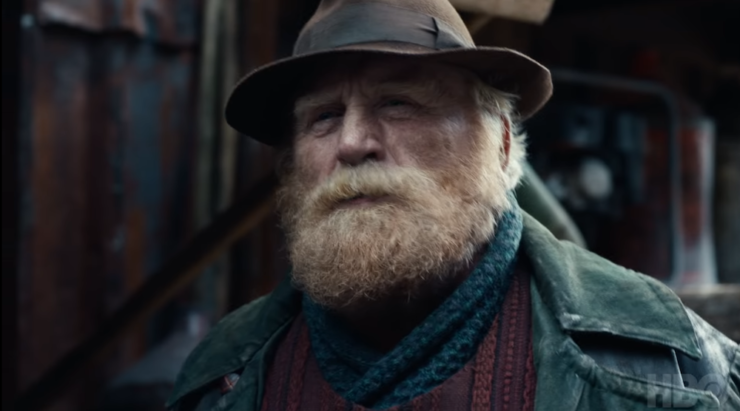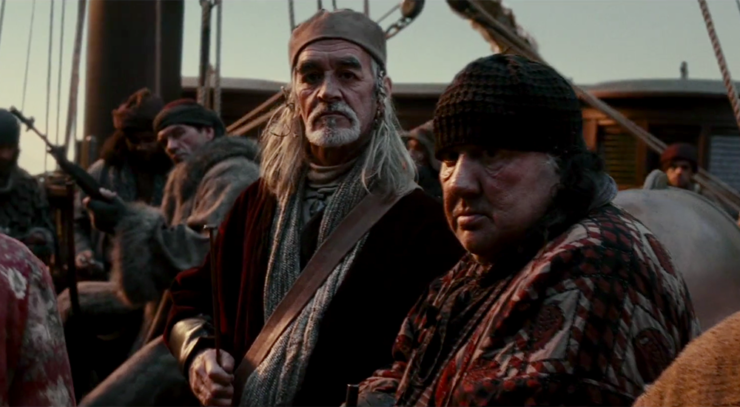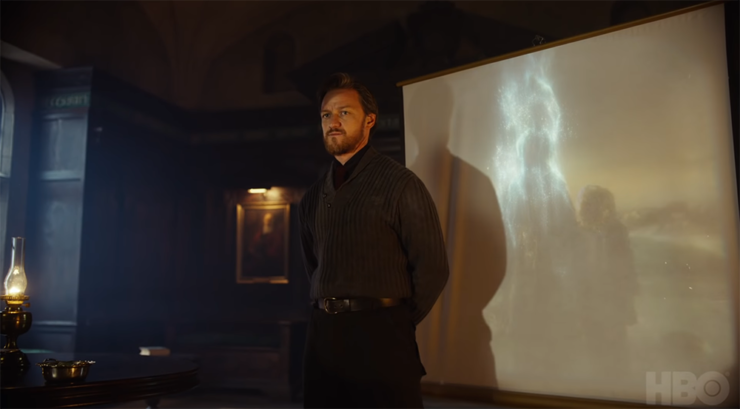One of the things I was most curious about in the lead up to the premiere of HBO/BBC’s His Dark Materials was how they would deal with the adaptation’s visual aesthetic. Philip Pullman is famously spare with description, leaving quite a bit up for interpretation. Further complicating this is the oddity of the setting itself: HDM is set in an alternate universe where the Catholic Church did not lose political power in England, altering the course of the last five centuries of European and North American history. It is ostensibly set in the present day (at least the present day of the first book, Northern Lights/The Golden Compass, 1995)—but because of the power of the Church along with other, more subtle alternate universe changes, it oughtn’t look like a mirror of the late 20th century. Essentially, HDM should look like a period piece of a period that never existed, but isn’t so alien as to make us forget that it takes place in a world that ought to seem uncannily familiar.
That’s admittedly no small task, but going by the premiere episode, “Lyra’s Jordan,” I think the look of the production is something they absolutely nailed. Beyond being thoughtful and splitting the uprights between “contemporary drama” and “fantastical period piece,” the overall look of the show also provides an interesting meta-commentary on Pullman’s place in the pantheon of British fantasy literature, some twenty years on from its publication.
Light on Fantasy

In comparing the look of the new 2019 series to the 2007 film, The Golden Compass, some major aesthetic changes become clear—most of which bend towards realism and subtlety. One of the central problems of that earlier film was its desire to make Pullman’s adventurous-but-grounded novel into a towering fantasy epic in the vein of New Line Cinema’s smash hit The Fellowship of the Ring six years earlier. Its costumes are not specific to any one time period or coherent theme, from a 1930s old-Hollywood starlet look for Nicole Kidman’s Mrs. Coulter and a fin-de-siècle dandy aesthetic for Daniel Craig’s Lord Asriel, to a mid-19th-century cowboy getup for Sam Elliott’s Lee Scoresby and (deep breath) a diaphanous pre-Raphaelite gown (swoon) with Slavic forest witch accoutrements (double-swoon) for Eva Green’s (triple-swoon, dead forever) Serafina Pekkala. It is, in short, a mess.
If we focus, for example, on the outfits of the gyptians, Pullman’s clan of nomadic riverfolk, the differences are fairly stark. Pullman’s gyptians take their inspiration from a variety of nomadic peoples but seem to be most inspired by the Roma. After all, their name is a play on a derogatory exonym for the Roma people. The 2007 film takes the gyptian-Roma connection very seriously, dressing its gyptian characters in colorful scarves and headwraps, embroidered cloaks, and fur-lined hats and jackets vaguely reminiscent of the Northern Indian, Central Asian Steppe, and Eastern European touchstones that people associate with Romani fashion. All of this is pushed to the extremes in TGC with Jim Carter’s portrayal of John Faa wearing dark eyeliner and a Mongolian halban. Looking at character posters and publicity shots, one could easily believe that the film was set in a pre-industrial fantasy world.

By contrast, the 2019 series seems to visually associate the gyptians with Irish Travelers more than Romani. Their outfits are not culturally distinct from the rest of the world but look like a hodgepodge of hand-me-down, durable clothing: plaid flannels, denim jeans, and heavy overcoats. Seeing as the vast majority of the first episode is set at Jordan College in Oxford, the gyptian clothing is one of the few windows into the world of everyday dress and it looks refreshingly contemporary. One might look at an image of Lucian Msamati’s John Faa and think you were seeing a period piece from the early ‘90s. He wears a trench coat over a wool sweater with a battered fedora as the only mark of flair.
Elsewhere in the series, the costumes of the Magisterium are sharply modern and only deviate slightly from what might be seen in a present-day boardroom by the subtle suggestion of a priestly collar in Father MacPhail’s vestments. Lord Boreal would not look out of place in any legal or political thriller. That contrasts sharply with TGC’s Magisterium, which blends baroque vestments and fascistic, angular silhouettes that might fit have right in in the wardrobe of Grand Moff Tarkin or a Starfleet Admiral.
This general commitment to a kind of realism and understatement in the costuming hews closer to Pullman’s vision of a world that, but for some key accidents of history, is identical to our own. The gyptians are not an Orientalized (in the Edward Said meaning of the term) “exotic” people whose culture is offered up for aesthetic consumption, but a marginalized group that is hard-pressed to simply stay afloat. They look like the poor, itinerant, and homeless of our everyday world. The overblown theological fascism of the 2007 film’s Magisterium was a delight to look at, but it was removed from the creeping authoritarian specters of reality—a consonance that is especially important to highlight in 2019. Pullman is invested in cold realism rather than escapism, and it is hard to look at humdrum familiarity of the series’ tyrant-priests and not feel a chill of recognition at how banal their everyday costume is.
HDM is not high fantasy. It is not even the rich and oversized political allegory of Game of Thrones; it is a show where you might not notice the foreignness of the world at all, if not for the daemons and airships.
An Assassin Among Kings

If there is any distinctive, non-contemporary flavor in His Dark Materials’ costuming, it is in its reference to styles from the late 1930s and early 1940s. Lord Asriel, especially, is dressed as the kind of early-cinema serial adventurer on which Indiana Jones was based: leather parka, snow goggles, and exquisitely tailored vest. Mrs. Coulter’s curls and wide-lapelled coats suggest a kind of old-Hollywood glitz which, though comparatively less opulent, is not so far from the flapper bangs and glittering evening-gowns Nicole Kidman sported in the 2007 film. But the suggestion of a sartorial early to mid-20th century finds less overt purchase in the tweed school uniforms of Jordan College faculty and students, as well as Lyra’s provincial overalls and Roger’s vests and undershirts. And it is in these aesthetic touches that the series insinuates itself into the very company that it is attempting to dismantle.
Pullman’s series is often called the “anti-Narnia,” insofar as it was marketed to children and told the story of a great adventure where pre-teens interact with talking animals…but was viciously anti-theist in its moral code. Pullman, an outspoken atheist, positioned his books as an ameliorative to what he saw as C.S. Lewis’ Christian indoctrination of fantasy-loving schoolchildren. Pullman’s choice to set Lyra’s childhood among the gargoyles and spires of Oxford and characterize it as a place of privilege and academic cowardice would certainly seem to be a shot across the bow at both Lewis and Tolkien, who were colleagues at Oxford (Lewis was a professor at Magdalen College and Tolkien taught at Pembroke and later Merton College).
Key to the character of Lewis’ novels, however, is not just an academic veneer over the English countryside (we must recall that 1950’s The Lion, The Witch, and the Wardrobe is partially set in the sprawling country manor of Professor Digory Kirke) but one temporally rooted in the 1940s. The four protagonists of the first book of Lewis’ allegory are sent to Professor Kirke’s after being evacuated from the Blitz. As much as anything, Lewis’ story is rooted in the keep-calm-and-carry-on perseverance of a critical moment in British self-conception. By giving viewers not only the requisite regalia of Lewis’ Oxford but also nods to the general style of the era in which his most famous book is set, His Dark Materials places itself in the same aesthetic space (and, thereby, perhaps the same space in our memory) as The Chronicles of Narnia. It becomes a visual match to the world Lewis inhabited and wrote about, ostensibly to sharpen its critique of its doppelgänger series’ theological precepts.
The Oxford academic costume is, of course, not just visually reminiscent of Lewis and Tolkien’s colleges (and of course, many of the series’ Oxford-set scenes were filmed in and around the university). A huge number of Americans will also likely associate the architecture and outfits of Oxford with that great third pillar of British fantasy children’s literature, Harry Potter. The film adaptations of J.K. Rowling’s books take direct inspiration for the look and feel of Hogwarts School of Witchcraft and Wizardry from Oxford’s Christ Church campus. In particular, a dinner scene in the first episode set in Jordan College’s dining hall where faculty face rows of cloaked and blazered students seems intended as a partial echo of Hogwart’s Great Hall dining scenes, themselves an echo of English boarding school practices.
HDM seems to be carrying out, at least at this early stage, a kind of visual espionage—cloaking itself in the raiment of beloved British fantasy and the styles and silhouettes of a specific, historical moment that is indelibly linked with the series (Narnia) that Pullman most detests. And, in a larger sense, it is replicating one of the central lessons of Pullman’s trilogy: appearances can be deceiving. This is a world where academic cowardice is masked as propriety, where vainglory pretends at bravery, where authoritarian violence masquerades as austere piety, and where even the device that infallibly tells the truth is an arcane contraption of byzantine, illegible symbols. His Dark Materials, the TV show, is wrapped up in all visual trappings of C.S. Lewis’ books. It incorporates intentional echoes of its own rival in the world of ‘90s children’s literature rival (Harry Potter and the Philosopher’s Stone came out in 1997, the same year as the second book in Pullman’s trilogy: The Subtle Knife), and is meant to root us in the same place and time in which Lewis and Tolkien brought forth the foundations of modern fantasy literature. But it is not like those things—Pullman’s books were meant to subvert and disrupt all of those things. It is their pharmakon: their poison or their cure, depending on your perspective; a world that’s built with a very different agenda in mind—the author’s antidote or corrective to everything that came before. And, I hope, this is all to the point of delivering a more harrowing coup d’état when the series begins to take on that legacy—and particularly Lewis’ legacy—more directly.
Tyler Dean is a professor of Victorian Gothic Literature. He holds a doctorate from the University of California Irvine and teaches at a handful of Southern California colleges. He is one half of the Lincoln & Welles podcast available on Apple Podcasts or through your favorite podcatcher. More of his writing can be found at his website and his fantastical bestiary can be found on Facebook at @presumptivebestiary.










